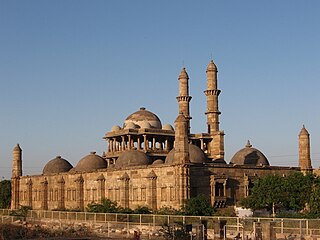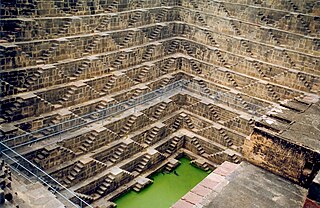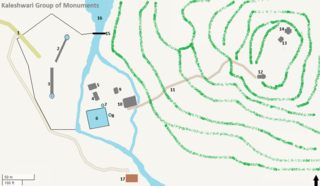
Mehsana, also spelled Mahesana, is a city and municipality in Mehsana district, in the Indian state of Gujarat. Established in 14th century, the city was under Gaekwads of Baroda State from 18th century to the independence of India in 1947. The municipality was established in 1919–20. The town has population of about 185,000. Dairy, oil and natural gas are major industries while there are several small and medium enterprises in the city.

Patan was the capital of Gujarat's Chalukya dynasty in medieval times. It is said to have been established by Vanraj Chavada, a Chavda king. The city has had an old history, with several Hindu and Muslim dynasties making it a thriving trading city and a regional capital of northern Gujarat. It was also known as 'Anhilpur-Patan'.

Bhavni Bhavai is a 1980 Gujarati film directed by Ketan Mehta, starring Naseeruddin Shah, Om Puri, Smita Patil, Mohan Gokhale, Benjamin Gilani. It tells the story of untouchability through folklore and Bhavai.

Palanpur is a city and a municipality of Banaskantha district in the Indian state of Gujarat. Palanpur is the administrative headquarters of Banaskantha district. Palanpur is the ancestral home to an industry of Indian diamond merchants.

Champaner-Pavagadh Archaeological Park, a UNESCO World Heritage Site, is located in Panchmahal district in Gujarat, India. It is located around the historical city of Champaner, a city which was founded by Vanraj Chavda, the most prominent king of the Chavda Dynasty, in the 8th century. He named it after the name of his friend and general Champa, also known later as Champaraj. The heritage site is studded with forts with bastions starting from the hills of Pavagadh, and extending into the city of Champaner. The park's landscape includes archaeological, historic and living cultural heritage monuments such as chalcolithic sites, a hill fortress of an early Hindu capital, and remains of the 16th-century capital of the state of Gujarat. There are palaces, entrance gates and arches, mosques, tombs and temples, residential complexes, agricultural structures and water installations such as stepwells and tanks, dating from the 8th to the 14th centuries. The Kalika Mata Temple, located on top of the 800 metres (2,600 ft) high Pavagadh Hill, is an important Hindu shrine in the region, attracting large numbers of pilgrims throughout the year.

Stepwells are wells or ponds in which the water is reached by descending a set of steps to the water level. They may be multi-storeyed with a bullock turning a water wheel to raise the well water to the first or second floor. They are most common in western India and are also found in the other more arid regions of the Indian subcontinent, extending into Pakistan. The construction of stepwells is mainly utilitarian, though they may include embellishments of architectural significance, and be temple tanks.

Adalaj is a census town in Gandhinagar district in the Indian state of Gujarat.

Khedbrahma is a town and a taluka headquarter in Khedbrahma Taluka of Sabarkantha district, Gujarat, India. It is situated on the banks of Harnav river. The town is connected with mythological history and has been pilgrim site for centuries. The 11th century Brahma, Ambika and Pankhnath Mahadev temples are the oldest monuments of the town. The town has two old stepwells, the Brahma stepwell and the Aditi stepwell. It was under Parmaras, Chaulukyas and Pariharas before it came under Idar State in 13th century.

Rani ki Vav or Ranki vav is a stepwell situated in the town of Patan in Gujarat state of India. It is located on the banks of Saraswati river. Its construction is attributed to Udayamati, daughter of Khengara of Saurashtra, queen of the 11th-century Solanki dynasty and spouse of Bhima I. Silted over, it was rediscovered in 1940s and restored in 1980s by the Archaeological Survey of India. It has been listed as one of UNESCO's World Heritage Sites since 2014.

Adalaj Stepwell or Rudabai Stepwell is a stepwell located in the village of Adalaj, close to Ahmedabad city and in Gandhinagar district in the Indian state of Gujarat, and considered a fine example of Indian architecture work. It was built in 1498 in the memory of Rana Veer Singh, by his wife Queen Rudadevi.

Amritavarshini Vav, also known as Panchkuva Stepwell or Katkhuni Vav, is a stepwell near the Panchkuva Darwaja in Ahmedabad, Gujarat, India.

Bai Harir Stepwell is a stepwell in Asarwa area 15 km off Ahmedabad, Gujarat, India.

Jethabhai's Stepwell or Jethabhai ni Vav, is a stepwell in Isanpur area of Ahmedabad, Gujarat, India. It was situated near sha e Alam and one of the heritage stepwells in Ahmedabad.
Stepwells are wells in which the water is reached by steps. They are most commonly found in western India especially Gujarat where over 120 such wells are reported. The origin of the stepwell may be traced to reservoirs of the cities of the Indus Valley Civilization such as Dholavira and Mohenjo-daro. The stepwells were constructed in the south western region of Gujarat around 600 AD. From there they spread north to Rajasthan and subsequently to north and west India. Construction activities accelerated during the 10th to 13th century during the Chaulukya and Vaghela periods. The construction of these stepwells hit its peak during the 11th to 16th century. The Muslim rulers of the 13th to 16th century did not disrupt the culture that was practiced in these stepwells and encouraged the building of stepwells. The wells lost their significance in the 19th century due to introduction of water pumps and pipe-systems.

The Kaleshwari Group of Monuments, also known as Kaleshwari-Ni Nal, is located near Lavana village, Khanpur Taluka of Mahisagar district, Gujarat, India. It is near the district headquarters Lunavada and near a stream in Hidimba Van, the forest of Hidimba. The group includes intricately-carved temple ruins, two stepwells, a reservoir, structures with panels of erotic sculptures and idols scattered all over the site. The ruins are located at the foothills and on the hillock. They were built between the 10th and 16th century; some monuments were reconstructed after the 18th century. These are State Protected Monuments.
Madhavav or Madhav Vav is a stepwell located in Wadhwan town of Surendranagar district, Gujarat, India. It is located in the western side of old town.

The Khed-Roda Group of Monuments include 8th-9th century dated seven Hindu temples built during Gurjara-Pratihara or Rashtrakuta period. It also include a reservoir (Kund) and a stepwell. They are located between Raisingpura (Roda) and Khed Chandarani villages, 18 km from Himmatnagar in Sabarkantha district of Gujarat, India. It is located on the bank of the seasonal stream which merges Hathmati river downstream.
Ra Khengar Vav or Ra Khengar stepwell is a 13th-century stepwell located near Koyliphatak village between Vanthali and Junagadh in Gujarat, India.

The Architecture of Gujarat consists of architecture in the Indian state of Gujarat.

Boter Kothani Vav, also known as Mehsana Vav or Interi Vav, is a stepwell located in Mehsana, Gujarat, India.


















